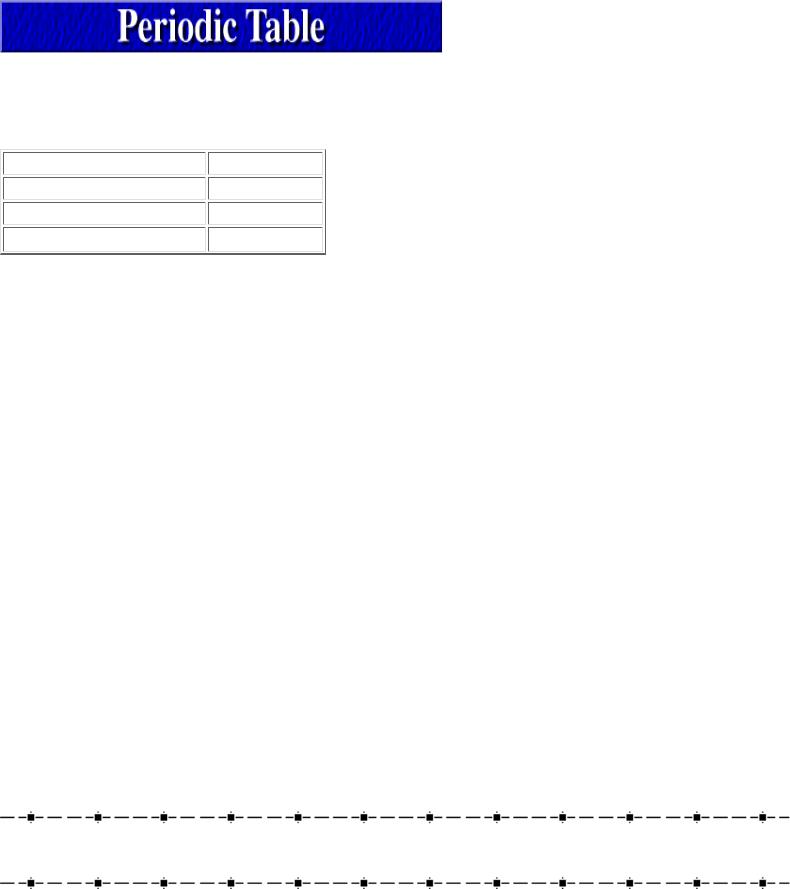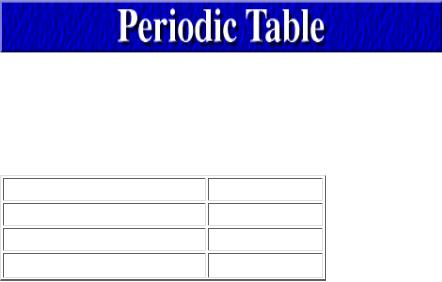
- •A Periodic Table of the Elements at Los Alamos National Laboratory
- •Hydrogen
- •Helium
- •Lithium
- •Beryllium
- •Boron
- •Carbon
- •Nitrogen
- •Oxygen
- •Fluorine
- •Neon
- •Sodium
- •Magnesium
- •Aluminum
- •Silicon
- •Phosphorus
- •Sulfur
- •Chlorine
- •Argon
- •Potassium
- •Calcium
- •Scandium
- •Tungsten
- •Zinc
- •Zirconium
- •Iron
- •Manganese
- •Antimony
- •Copper
- •Silver
- •Nickel
- •Chromium
- •Vanadium
- •Yttrium
- •Titanium
- •Molybdenum
- •Common Isotopes
- •Mercury
- •Cobalt
- •Lead
- •Gallium
- •Cesium
- •Rubidium
- •Germanium
- •Arsenic
- •Selenium
- •Bromine
- •Krypton
- •Strontium
- •Niobium
- •Technetium
- •Ruthenium
- •Rhodium
- •Palladium
- •Cadmium
- •Indium
- •Tellurium
- •Iodine
- •Xenon
- •Barium
- •Lanthanum
- •Hafnium
- •Tantalum
- •Rhenium
- •Platinum
- •Iridium
- •Osmium
- •Gold
- •Thallium
- •Bismuth
- •Polonium
- •Astatine
- •Radon
- •Francium
- •Radium
- •Actinium
- •Rutherfordium
- •Hahnium
- •Seaborgium
- •Nobelium
- •Neilsborium
- •Hassium
- •Meitnerium
- •Element 110
- •Element 111
- •Element 112
- •Mysterious Elements 114, 116, & 118
- •Cerium
- •Thorium
- •Europium
- •Praseodymium
- •Neodymium
- •Promethium
- •Samarium
- •Gadolinium
- •Terbium
- •Dysprosium
- •Holmium
- •Erbium
- •Thulium
- •Ytterbium
- •Lutetium
- •Protactinium
- •Uranium
- •Neptunium
- •Plutonium
- •Americium
- •Curium
- •Berkelium
- •Californium
- •Einsteinium
- •Fermium
- •Mendelevium
- •Lawrencium
- •Element Listing
- •Tell us or ask us
- •What is the Periodic Table?
- •How to Use the Periodic Table
- •Nutshell Chemistry
- •Mendeleev's Table
- •PERIODIC TABLE OF THE ELEMENTS

Protactinium
 Protactinium
Protactinium
History
(Gr. protos, first) The first isotope of element 91 to be discovered was 234Pa, also known as UX2, a short-lived member of the naturally occurring 238U decay series. It was identified by K. Fajans and O.H. Gohring in 1913 and the named the new element brevium. When the longer-lived isotope 231-Pa was identified by Hahn and Meitner in 1918, the name protoactinium was adopted as being more consistent with the characteristics of the most abundant isotope. Sody, Cranson, and Fleck were also active in this work. The name protoactinium was shortened to protactinium in 1949. In 1927, Grosse prepared 2 mg of a white powder, which was shown to be Pa2O5. Later, in 1934, from 0.1 g of pure Pa2O5 he isolated the element by two methods, one of which was by converting the oxide to an iodide and "cracking" it in a high vacuum by an electrically heated filament by the reaction: 2PaI5 --> 2Pa + 5I2. Protactinium has a bright metallic luster which it retains for some time in air. The element occurs in pitchblende to the extent of about 1 part 231Pa to 10 million of ore. Ores from Zaire have about 3 ppm. Protactinium has 20 isotopes, the most common of which is 231Pa with a half-life of 32,700 years. A number of protactinium compounds are known, some of which are colored. The element is superconductive below 1.4K. The element is a dangerous material and requires precautions similar to those used when handling plutonium. In 1959 and 1961, it was announced that the Great Britain Atomic Energy Authority extracted by a 12-stage process 125 g of 99.9% protactinium, the world's only stock of the metal for many years to come. The extraction was made from 60 tons of waste material at a cost of about $500,000. Protactinium is one of the rarest and most expensive naturally occurring elements. O.R.N.L. supplies promethium-231 at a cost of about $280/g. The elements is an alpha emitter (5.0 MeV) and is a radiological hazard similar to polonium.
Sources: CRC Handbook of Chemistry and Physics and the American Chemical Society.
Last Updated: 12/19/97, CST Information Services Team
http://pearl1.lanl.gov/periodic/elements/91.html [3/6/2001 8:38:24 AM]

Uranium
 Uranium
Uranium
For Nuclear Fission
History
(Planet Uranus) Yellow-colored glass, containing more than 1% uranium oxide and dating back to 79 A.D., has been found near Naples, Italy. Klaproth recognized an unknown element in pitchblende and attempted to isolate the metal in 1789.
The metal apparently was first isolated in 1841 by Peligot, who reduced the anhydrous chloride with potassium.
Sources
Uranium, not as rare as once thought, is now considered to be more plentiful than mercury, antimony, silver, or cadmium, and is about as abundant as molybdenum or arsenic. It occurs in numerous minerals such as pitchblende, uraninite, carnotite, autunite, uranophane, and tobernite. It is also found in phosphate rock, lignite, monazite sands, and can be recovered commercially from these sources.
The United States Department of Energy purchases uranium in the form of acceptable U3O8 concentrates. This incentive program has greatly increased the known uranium reserves.
Uranium can be prepared by reducing uranium halides with alkali or alkaline earth metals or by reducing uranium oxides by calcium, aluminum, or carbon at high temperatures. The metal can also be produced by electrolysis of KUF5 or UF4, dissolved in a molten mixture of CaCl2 and
NaCl. High-purity uranium can be prepared by the thermal decomposition of uranium halides on a hot filament.
Properties
Uranium exhibits three crystallographic modifications as follows: alpha --(688C)--> beta --(776C)--> gamma. Uranium is a heavy, silvery-white metal which is pyrophoric when finely divided.
http://pearl1.lanl.gov/periodic/elements/92.html (1 of 3) [3/6/2001 8:38:24 AM]
Uranium
It is a little softer than steel, and is attacked by cold water in a finely divided state. It is malleable, ductile, and slightly paramagnetic.
In air, the metal becomes coated with a layer of oxide. Acids dissolve the metal, but it is unaffected by alkalis.
Isotopes
Uranium has sixteen isotopes, all of which are radioactive. Naturally occurring uranium nominally contains 99.28305 by weight 238U, 0.7110% 235U, and 0.0054% 234U. Studies show that the percentage weight of 235U in natural uranium varies by as much as 0.1%, depending on the source. The US DOE has adopted the value of 0.711 as being their official percentage of 235U in natural uranium. Natural uranium is sufficiently radioactive to expose a photographic plate in an hour or so.
Much of the internal heat of the earth is thought to be attributable to the presence of uranium and thorium.
Uranuim-238 with a half-life of 4.51 x 109 years, has been used to estimate the age of igneous rocks. The origin of uranium, the highest member of the naturally occurring elements - except perhaps for traces of neptunium or plutonium, is not clearly understood. However it may be presumed that uranium is a decay product of elements with higher atomic weight, which may have once been present on earth or elsewhere in the universe. These original elements may have been formed as a result of a primordial creation, known as the big bang, in a supernova, or in some other stellar processes.
Uses
Uranium is of great importance as a nuclear fuel. Uranium-238 can be converted into fissionable plutonium by the following reactions: 238U(n, gamma) --> 239U --(beta)--> 239Np --(beta)--> 239Pu. This nuclear conversion can be brought about in breeder reactors where it is possible to produce more new fissionable material than the fissionable material used in maintaining the chain reaction.
Uranium-235 is of even greater importance because it is the key to utilizing uranium. 235U, while occuring in natural uranium to the extent of only 0.71%, is so fissionable with slow neutrons that a self-sustaining fission chain reaction can be made in a reactor constructed from natural uranium and a suitable moderator, such as heavy water or graphite, alone.
Uranium-235 can be concentrated by gaseous diffusion and other physical processes, if desired, and used directly as a nuclear fuel, instead of natural uranium, or used as an explosive.
Natural uranium, slightly enriched with 235U by a small percentage, is used to fuel nuclear power reactors to generate electricity. Natural thorium can be irradiated with neutrons as follows to produce the important isotope 233U: 232Th(n, gamma)--> 233Th --(beta)--> 233Pa --(beta)--> 233U. While thorium itself is not fissionable, 233U is, and in this way may be used as a
http://pearl1.lanl.gov/periodic/elements/92.html (2 of 3) [3/6/2001 8:38:24 AM]

Uranium
nuclear fuel. One pound of completely fissioned uranium has the fuel value of over 1500 tons of coal.
The uses of nuclear fuels to generate electrical power, to make isotopes for peaceful purposes, and to make explosives are well known. The estimated world-wide capacity of the 429 nuclear power reactors in operation in January 1990 amounted to about 311,000 megawatts.
Uranium in the U.S.A. is controlled by the U.S. Nuclear Regulatory Commission. New uses are being found for depleted uranium, ie., uranium with the percentage of 235U lowered to about 0.2%.
Uranium is used in inertial guidance devices, in gyro compasses, as counterweights for aircraft control surfaces, as ballast for missile reentry vehicles, and as a shielding material. Uranium metal is used for X-ray targets for production of high-energy X-rays; the nitrate has been used as a photographic toner, and the acetate is used in analytical chemistry.
Crystals of uranium nitrate are triboluminescent. Uranium salts have also been used for producing yellow "vaseline" glass and glazes. Uranium and its compounds are highly toxic, both from a chemical and radiological standpoint.
Handling
Finely divided uranium metal, being pyrophoric, presents a fire hazard.
Working with uranium requires the knowledge of the maximum allowable concentrations that may be inhaled or ingested.
Recently, the natural presence of uranium in many soils has become of concern to homeowners because of the generation of radon and its daughters.
Sources: CRC Handbook of Chemistry and Physics and the American Chemical Society.
Last Updated: 12/19/97, CST Information Services Team
http://pearl1.lanl.gov/periodic/elements/92.html (3 of 3) [3/6/2001 8:38:24 AM]
